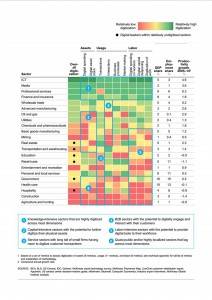April 4, 2016
Growing divide in US firms between the digital haves and have-mores 0
 Last week we reported on the ways in which the UK government and British firms are falling short in their approaches to the increasingly digital world. It would be wrong to assume that this is solely an issue on this side of the pond however. A recent report from McKinsey highlights how specific sectors and businesses in the US are also sometimes struggling to meet the challenges and embrace the opportunities presented to them by the digitisation of the economy. The report suggests that overall US firms are only realising around 18 percent of their ‘digital potential’ and the major challenge the US faces is no longer bridging the gap between the digital have and have-nots, but the digital haves and have-mores. Intriguingly the report also breaks down this divide by individual sectors, thereby highlighting those parts of the economy that stand to gain most from bridging the digital divide.
Last week we reported on the ways in which the UK government and British firms are falling short in their approaches to the increasingly digital world. It would be wrong to assume that this is solely an issue on this side of the pond however. A recent report from McKinsey highlights how specific sectors and businesses in the US are also sometimes struggling to meet the challenges and embrace the opportunities presented to them by the digitisation of the economy. The report suggests that overall US firms are only realising around 18 percent of their ‘digital potential’ and the major challenge the US faces is no longer bridging the gap between the digital have and have-nots, but the digital haves and have-mores. Intriguingly the report also breaks down this divide by individual sectors, thereby highlighting those parts of the economy that stand to gain most from bridging the digital divide.
 The report defines the digital laggards as those sectors which are less than 15 percent as digitised as the leading sectors, a gap it suggests has been growing exponentially since the late 1990s. Looking at just three major areas of potential; online talent platforms, big data analytics, and the Internet of Things, the report estimates that digitisation could add up to $2.2 trillion to annual US GDP by 2025.
The report defines the digital laggards as those sectors which are less than 15 percent as digitised as the leading sectors, a gap it suggests has been growing exponentially since the late 1990s. Looking at just three major areas of potential; online talent platforms, big data analytics, and the Internet of Things, the report estimates that digitisation could add up to $2.2 trillion to annual US GDP by 2025.
It is perhaps not surprising to see that IT and media companies are identified as amongst the most digitised (see graphic) but there are clearly opportunities within the built environment sectors of real estate and construction, albeit that real estate gets a bit of a plus point in the report for the way it stands out in a comparatively ‘undigitised’ sector.
[embedplusvideo height=”283″ width=”450″ editlink=”https://bit.ly/224v3bg” standard=”https://www.youtube.com/v/hboFgWVyIKA?fs=1&vq=hd720″ vars=”ytid=hboFgWVyIKA&width=450&height=283&start=&stop=&rs=w&hd=1&autoplay=0&react=0&chapters=¬es=” id=”ep2146″ /]














